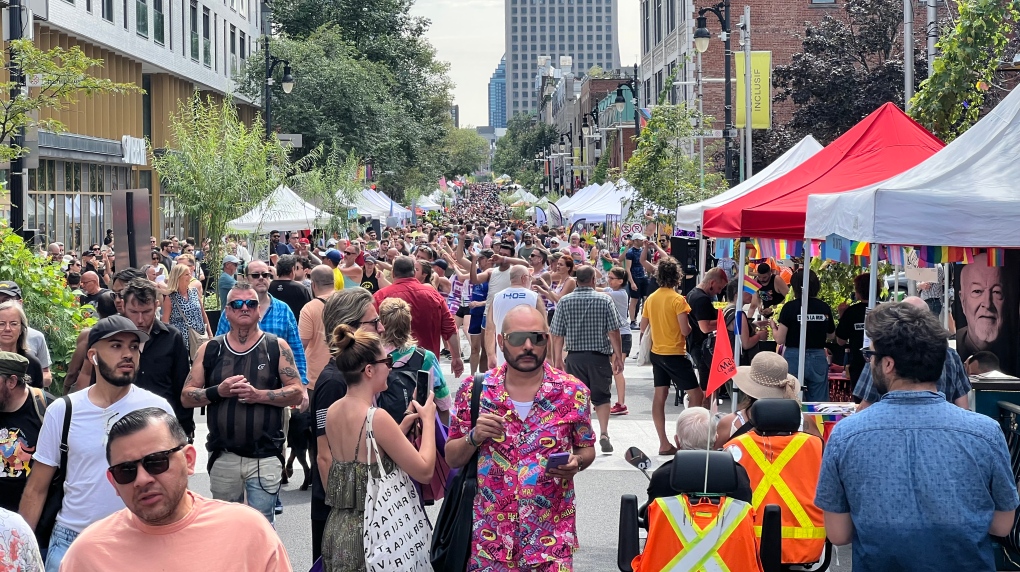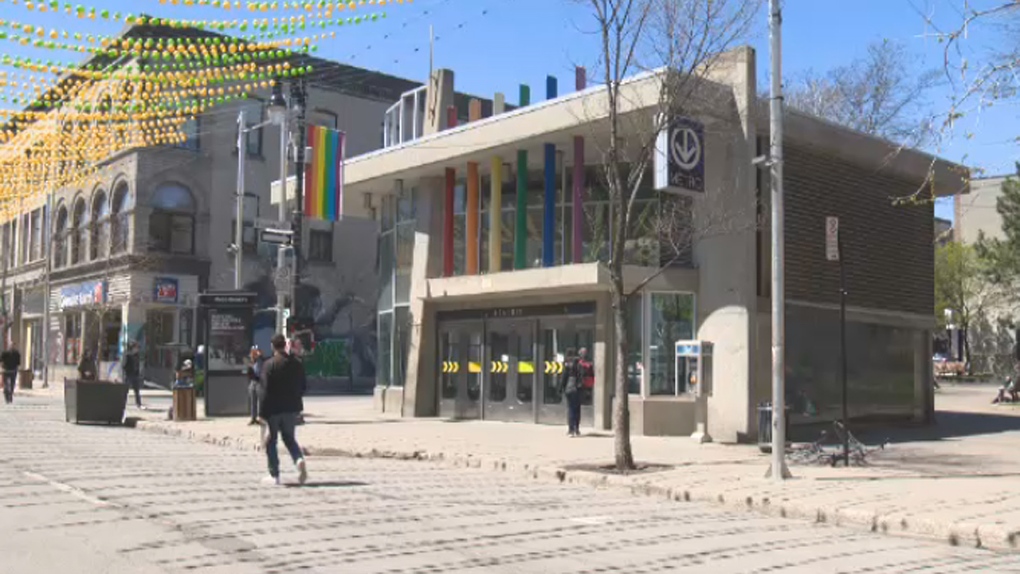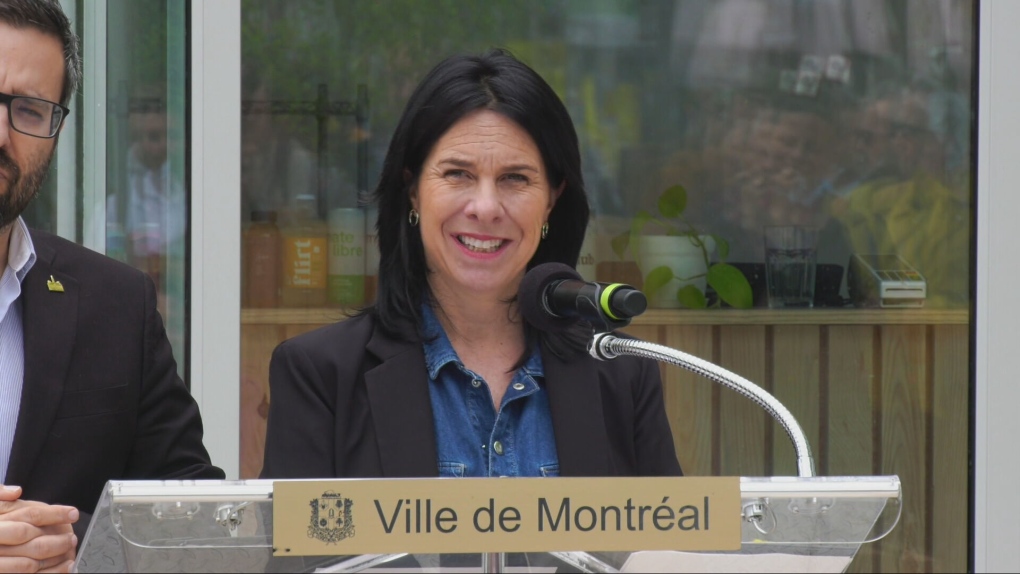Survey confirms Montreal residents still feel unsafe going to the Village
 Montreal police in the Village neighbourhood. (Dave Touniou, CTV News)
Montreal police in the Village neighbourhood. (Dave Touniou, CTV News)
A new survey shows most people don't feel safe in Montreal's Village and believe the situation in one of the city's most vibrant neighbourhoods has only gotten worse in recent years.
The survey was done by the Citizens Association of the Village of Montreal, a new community group formed last June, with more than 200 members. The association gathered responses in August and September from 718 people reached by mail, social media and door-to-door pamphlets.
Released Monday, the results showed that 68.2 per cent believe the Village to be not very safe or not at all safe, while more than 66 per cent said the quality of life was poor or very poor.
 Thousands were in The Village in Montreal on Aug. 12, 2023 as the MTL Pride festivities lead up to the annual parade. (Daniel J. Rowe/CTV News)
Thousands were in The Village in Montreal on Aug. 12, 2023 as the MTL Pride festivities lead up to the annual parade. (Daniel J. Rowe/CTV News)
Alain Hébert, head of the security committee of the citizens association, said he was surprised by the numbers, which made it clear to him that, "people feel that the situation is a little bit out of control."
"People clearly tell you, 'I try not to go to that stretch of Sainte-Catherine, or that section of Ontario Street, some parks,'" he told CTV News.
"We shouldn't have to say, 'I'm not going to go to this grocery store because when I come out, if it's after six [o'clock], it's dark, I won't feel comfortable. It's something that should be basic for all citizens of the city."
Beaudry Metro among most unsafe spots: survey
People who filled out the survey provided information on what areas they tend to avoid, including Beaudry Metro station (72.89 per cent). Other unsafe places identified included Place Émilie-Gamelin (65.6 per cent), Place du Village (50.1 per cent), Place Emmett-Johns (48.7 per cent), Charles-S. Campbell (41.5 per cent), and des Faubourgs (20.5 per cent).
 The Beaudry metro station sees 1.5 million visits per year, making it the 63rd busiest station in the 68-station network
The Beaudry metro station sees 1.5 million visits per year, making it the 63rd busiest station in the 68-station network
The stretch of Sainte-Catherine between Berri and Atateken streets was where the greatest number of people (77.2 per cent) said they felt the most unsafe.
Seeing police officers and community workers on the streets made people feel safer, according to the survey, though between 15 per cent and 23 per cent of respondents said such interventions had little to no impact.
Sending a message to politicians
While the perception of the neighbourhood is a negative one, the people who responded to the survey say they care about the area and want to find solutions to problems such as homelessness, hard drug use and violence, Hébert said.
That's the message the association hopes to send to elected officials.
"When we talk to politicians, they're telling us, well, it's all over the island at this time. But the reality is that this neighbourhood, right now, is really the epicentre of the problem," Hébert said.
"People have to realize that in this section of town, we need special help right now in order to bring a quality of life back to its citizens."
 Montreal Mayor Valerie Plante speaks at a news conference about new funding for social and economic initiatives in the Village on May 16, 2024. (CTV News)
Montreal Mayor Valerie Plante speaks at a news conference about new funding for social and economic initiatives in the Village on May 16, 2024. (CTV News)
The survey did show, however, that people view the Village in a positive light when it comes to entertainment. Just over 80 per cent felt that activities and shows in local venues had a very positive or positive impact on their sense of safety.
"It's important to understand that the purpose of this survey is not to say that the Village is unsafe and should not be frequented," said association president Sylvain Côté in a statement. "On the contrary, we believe that by looking at the problems head-on, we will be able to identify the main issues that create this widespread feeling of insecurity, and the actions that should be prioritized."
More than 600 respondents provided additional feedback with recommendations on how to make the Village safer and, according to Côté, the message was clear: "The various levels of government will have to work together quickly to change the situation, which has reached a critical point in the Village."
The respondents were between 18 and 79 years old and live in the Village area.
Here is a breakdown of how they identified themselves:
- Gay men — 54 per cent
- Heterosexual — 25.6 per cent
- Bisexual — 4.9 per cent
- Pansexual — 2.8 per cent
- Queer — 2.6 per cent
- Lesbian — 2.2 per cent
- Asexual — 0.6 per cent
- Other — 0.3 per cent
- Preferred not to answer — 7 per cent
With files from CTV Montreal's Kelly Greig
CTVNews.ca Top Stories

Sparks fly as MPs question minister on pension implications of proposed election date change
Sparks flew at a parliamentary committee Thursday as MPs questioned Canada's democratic institutions minister about a widely opposed provision in electoral reform legislation that seeks to delay the next fixed election date by one week.
'There is no electricity': Canadian travellers in Cuba urge caution in hurricane's wake
Cuba's power grid was knocked out by Hurricane Rafael, which ripped across the country as a Category 3 storm. In western Cuba, it toppled buildings and pushed 50,000 people to find shelter elsewhere. Cubans were already enduring rolling blackouts due to energy shortages.
Three charged in One Direction singer Liam Payne's death
Three people have been charged in relation to One Direction singer Liam Payne's death in a fall from his Buenos Aires hotel balcony last month, Argentine authorities said on Thursday.
RCMP already 'on high alert' for potential wave of migrants after Trump election
Canada's federal police force has been preparing for months on a contingency plan for a potential massive influx of migrants across the border following Trump's promise of 'mass deportations' of millions of undocumented immigrants in the U.S.
'There was no stopping this baby from coming': Woman gives birth while aboard Newfoundland ferry
A young family from Codroy Valley, N.L., is happy to be on land and resting with their newborn daughter, Miley, after an overwhelming, yet exciting experience at sea.
Volkswagen models recalled for airbag safety precaution
Recall notices have been issued for some Volkswagen models from 2006 to 2019 for airbag safety issues.
Canmore wildlife and landscape defender Karsten Heuer dies peacefully at 56
Canmore conservationist Karsten Heuer, who was a biologist, park ranger, author and activist, has died.
America votes: How celebrities are reacting to Trump's decisive victory
Celebrities from Hulk Hogan to Ariana Grande are sharing their reactions to the U.S. election, which will see Donald Trump return to the White House.
3 Winnipeg police officers charged with breach of trust, theft
Three members of the Winnipeg Police Service have been charged with breach of trust, obstruction of justice and theft following a lengthy investigation


































